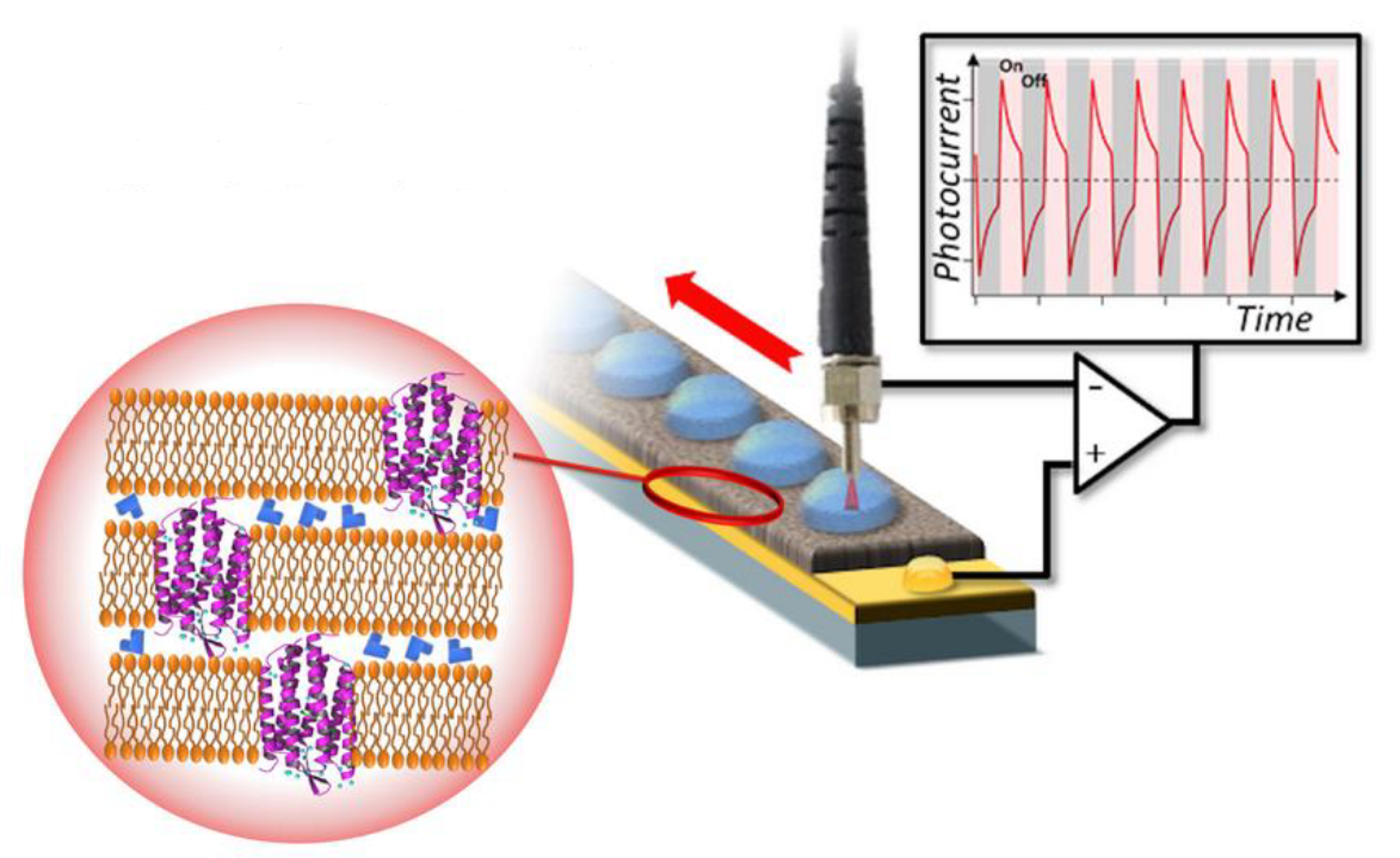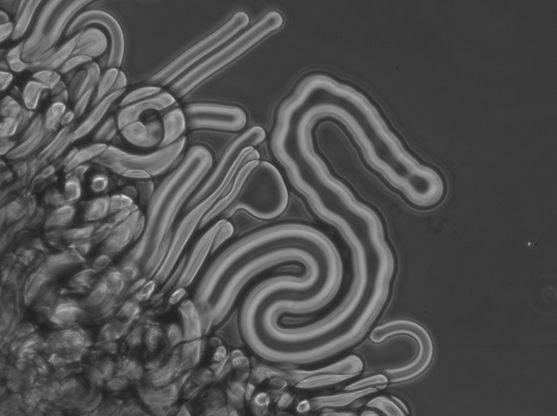Biomimetic (Opto)Electronic Devices
Research focus of AG Reissig
The aim of the research conducted in AG Reissig is to develop biomimetic optoelectronic devices, through the emulation of biological systems that have been optimized over centuries of evolution, or through the incorporation of biomolecules into artificial constructs which are optimized to support their native structure and structural changes upon external stimulation. Our focus is primarily on biological soft matter systems, where the components are mobile, and can adapt depending on the various inter- and intramolecular interactions with themselves, as well as with other components and interfaces. The guiding principle of this research is to develop a thorough mechanistic understanding through fundamental studies and by comparison to model synthetic systems, and is driven by a vision towards applications through the formation of real devices, whose performance is tested, compared and improved.
Within this field, the focus lies primarily on the following four themes:
1) Diatoms as photonic building blocks (funded by DFG)
The siliceous frustules of diatoms characteristically show highly regular structuring on length scales stretching from the nanometer to the micrometer range. This structuring has been proposed to impart unique optical properties, similar to 2D or 3D photonic crystals. To obtain artificial materials with nano-structures, advanced techniques are being developed with the aim of inducing novel photonic and plasmonic effects, desirable for optical or optoelectronic applications. The purpose of this project is to explore the use of diatom frustules as nanostructures and nanostructured templates in optical elements and optoelectronic devices. Starting with our novel photodetector architecture (MIS(I)M), diatom frustules are introduced as building blocks into practical devices, and their performance tested. Surface functionalization strategies are explored to develop and enhance the desired optical and/or electronic properties. We aim to improve the device performance, as well as to optimize the device architecture to fully benefit from the unique structural features of the diatom frustules.
see e.g. L. Reissig, M.M. Ghobara, C. Maibohm, J.W. Goessling A Journey to Mars with Diatoms on Board In: Diatoms Photosynthesis, Wiley-Scrivener, Ed.: J.W. Goessling, J. Serôdio and J. Lavaud 18:553-582 2024 DOI:10.1002/9781119842156.ch18
M. Gilic, M. Ghobara, L. Reissig Tuning SERS Signal via Substrate Structuring: Valves of Different Diatom Species with Ultrathin Gold Coating Nanomaterials 13(10):1594 2023 DOI:10.3390/nano13101594
M.M. Ghobara, C. Oschatz, P. Fratzl, L. Reissig Numerical Analysis of the Light Modulation by the Frustule of Gomphonema parvulum: The Role of Integrated Optical Components Nanomaterials 13(1):130 2023 DOI:10.3390/nano13010113
M.M. Ghobara, N. Mazumder, V. Vinayak, L. Reissig, I.C. Gebershuber, M.A. Tiffany, R. Gordon On Light and Diatoms: A Photonics and Photobiology Review In: Diatoms Fundamentals and Applications, Wiley, Ed.: J. Seckbach and R. Gordon ISBN: 978-1-119-37021-5
L. Reissig, S. Dalgleish, K. Awaga Towards high-bandwidth organic photodetection based on pure active layer polarization Scientific Reports 8:15415 2018 DOI:10.1038/s41598-018-33822-z
L. Reissig, S. Dalgleish, K. Awaga A differential photodetector: Detecting light modulations using transient photocurrents AIP Advances 6(1):015306 2016 DOI:10.1063/1.4939921
2) Protein photodetectors
Microbial rhodopsins are a group of photoactive proteins often considered as the "eyes of microbes", as they are not only structurally similar to the light receptors in our eyes, but also undergo light-induced structural changes that can lead to signalling cascades within the microbes to lead them toward favourable territories, or to the production of energy. In 2015, we developed with our Japanese partners in Nagoya and Okayama a prototype differential photodetector based on a photoactive rhodopsin film. The aim of this project is to increase the performance of such protein photodetectors, and to correlate their performance with the properties of the proteins under study.
see e.g. L. Reissig, K. Buchanan, Th. Lindner, M. Kurihara, P.-Ch. Chan, F. Kibowski, K. Kojima, S. Dalgleish, K. Awaga, Y. Sudo The use of microbial rhodopsin proteins in differential photodetection Frontiers in Physics: Optics and Photonics 12 2024 DOI:10.3389/fphy.2024.1481341
S. Dalgleish, L. Reissig, Y. Sudo, K. Awaga On-Tip Photodetection: A Simple and Universal Platform for Optoelectronic Screening Chemical Communications 51(91):16401-16404 2015 DOI:10.1039/c5cc06237c
L. Reissig, S. Dalgleish, K. Awaga A differential photodetector: Detecting light modulations using transient photocurrents AIP Advances 6(1):015306 2016 DOI:10.1063/1.4939921

On-Tip Photodetection using a Photoactive Protein Film
3) Novel architectures and materials for bioinspired and "green" photodetection (funded by initiatives of the FU "ProFund Innovation" as well as Internationalisation strategies by the FU, DFG and DAAD)
Inspired by nature, we are looking at novel architectures to detect light. We work on the development of a multipixel "DiffEye" image sensor, in which a intrinsic cross-talk between adjacent pixels (inspired by the cross-talk experienced in animals eyes) changes the image we see without the need of further image processing tools. Furthermore, every day new materials are developed. In a collaborative work with partners in India and Serbia, we work on the utilisation of novel inorganic materials, such as lead-free ferroelectric materials, with the aim of not only developing photodetectors of superior performance, but also add functionality.
see e.g. L. Reissig (Dalgleish), S. Dalgleish, A. Singh Radiation detector European Patent application nb: WO2021032507-A1, Priority date: 21.08.2019, International publication date: 25.02.2021
4) Artificial myelin figures and their use in photonic devices
Artificial myelin figures resemble, both in structure and properties, the myelin sheaths surrounding the nerve axon in a large number of vertebrates, which serve to improve neural signal strength, speed and energy efficiency. The strongly uniaxial signal conduction along the myelin axon, where the insulating bilayer sheaths shield signal transfer within the myelin from the conductive medium surrounding them, make them suitable targets for artificial "wires" through aqueous solutions. This project aims to exploit these structures in real devices and circuits, as well as contribute to the fundamental understading of myelin structures, and the phase behaviour of surfactants (lipids, blockcopolymers) far from equilibrium.
see e.g. L. Reissig, D.J. Fairhurst, J. Leng, M.E. Cates, A.R. Mount, S.U. Egelhaaf Three-Dimensional Structure and Growth of Myelins Langmuir 26(19):15192-9 2010 DOI:10.1021/la102726r

Myelin Figures during the Dissolution of the non-ionic surfactant C12E3
5) In operando ATR-FTIR spectroscopy
FTIR spectroscopy, a technique which is sensitive to the vibrations of particular chemical groups in complex molecules, is a powerful tool to study the structure and structural changes of macro-molecules/systems upon external stimuli. By performing in operando measurements combined with impedance spectroscopic analysis on our photodetector devices we aim to add to the understanding of the optoelectronic processes within the devices, as well as the influence of electric fields on the biomolecules themselves. Such studies would also shed light on the specific interactions at the various complex interfaces that exist within the devices.
see e.g. L. Reissig, T. Iwata, T. Kikukawa, M. Demura, N. Kamo, H. Kandori, Y. Sudo Influence of Halide Binding on the Hydrogen Bonding Network in the Active Site of Salinibacter Sensory Rhodopsin I Biochemistry 51(44):8802–8813 2012 DOI:10.1021/bi3009592